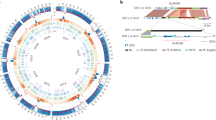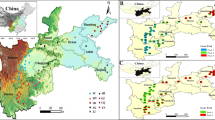Abstract
Cultivated carrots can be divided into eastern and western types. Much evidence supports the idea that eastern carrots originated in Central Asia, while varying opinions exist on the origin of western carrots, especially orange varieties, and the origin of Chinese orange carrots remains unclear. In this study, we used 119 carrot accessions to investigate the relationship between Chinese carrots and western orange varieties (Western orange) using morphology and simple sequence repeat (SSR) markers. The results demonstrate that Chinese carrots are eastern-type and maintain the primitive traits of strong and pubescent leaves, and early flowering. Despite being morphologically similar, the STRUCTURE and phylogenetic analysis based on SSR markers indicated that Western orange were clearly separated from Chinese carrots. These findings, in conjunction with historical documents suggesting that the first Chinese carrots seem to be yellow, suggest that Chinese orange were derived from Chinese red according to the mixed distribution of red and orange accessions. These results suggest that Chinese orange carrots may have undergone a specific, independent process different from that of Western orange.



Similar content being viewed by others
References
Ali A, Matthews WC, Cavagnaro PF, Iorizzo M, Roberts PA, Simon PW (2013) Inheritance and mapping of Mj-2, a new source of root-knot nematode (Meloidogyne javanica) resistance in carrot. J Hered 105(2):288–291
Arango J, Jourdan M, Geoffriau E, Beyer P, Welsch R (2014) Carotene hydroxylase activity determines the levels of both a-carotene and total carotenoids in orange carrots. Plant Cell. doi:10.1105/tpc.113.122127
Banga O (1957) Origin of the European cultivated carrot. Euphytica 6:54–63
Banga O (1976) Carrot. In: Simmonds NW (ed) Evolution of crop plants. Longmans, London, pp 291–293
Baranski R, Maksylewicz-Kaul A, Nothnagel T, Cavagnaro P, Simon P, Grzebelus D (2012) Genetic diversity of carrot (Daucus carota L.) cultivars revealed by analysis of SSR loci. Genet Resour Crop Evol 59:163–170
Briard M, Le Clerc V, Grzebelus D, Senalik D, Simon PW (2000) Modified protocols for rapid carrot genomic DNA extraction and AFLP™ analysis using silver stain or radioisotopes. Plant Mol Biol Rep 18:235–241
Cavagnaro PF, Chung SM, Manin S, Yildiz M, Ali A, Alessandro MS, Iorizzo M, Senalik DA, Simon PW (2011) Microsatellite isolation and marker development in carrot—genomic distribution, linkage mapping, genetic diversity analysis and marker transferability across apiaceae. BMC Genom 12:386–407
Cavagnaro PF, Iorizzo M, Yildiz M, Senalik D, Parsons J, Ellison S, Simon PW (2014) A gene-derived SNP-based high resolution linkage map of carrot including the location of QTL conditioning root and leaf anthocyanin pigmentation. BMC Genom 15:1118–1136
Clotault J, Geoffriau E, Lionneton E, Briard M, Peltier D (2010) Carotenoid biosynthesis genes provide evidence of geographical subdivision and extensive linkage disequilibrium in the carrot. Theor Appl Genet 121:659–672
Detlef G, Stefanie H, Sebastian K, Joachim S (2013) Principal components analysis. Methods Mol Biol 930:527–547
Evanno G, Regnaut S, Goudet J (2005) Detecting the number of clusters of individuals using the software structure: a simulation study. Mol Ecol 14:2611–2620
Grzebelus D, Iorizzo M, Senalik D, Ellison S, Cavagnaro PF, Alicja MP, Kasia HU, Kilian A, Thomas N, Allender C, Simon PW, Rafal B (2014) Diversity, genetic mapping, and signatures of domestication in the carrot (Daucus carota L.) genome, as revealed by diversity arrays technology (DArT) markers. Mol Breeding 33:625–637
Heywood VH (1983) Relationships and evolution in the Daucus carota complex. Isr J Ecol Evol 32:51–65
Iorizzo M, Douglas AS, Shelby LE, Grzebelus D, Cavagnaro PF, Allender C, Brunet J, Spooner DM, Allen DV, Simon PW (2013) Genetic structure and domestication of carrot (Daucus carota subsp. stivus) (Apiaceae). Am J Bot 100:930–938
IPGRI (2003) Descriptors for wild and cultivated carrots (Daucus carota L.). International Plant Genetic Resources Institute, Rome
Laufer B (1919) The carrot. Sino-Iranica: Chinese contributions to the history of civilization in ancient Iran with special reference to the history of cultivated plants and products. Field Museum of Natural History, Chicago, pp 451–454
Liu KJ, Muse SV (2005) PowerMarker: an integrated analysis environment for genetic marker date. Bioinformatics 9:2121–2129
Mezghani N, Zaouali I, Amri WB, Rouz S, Simon PW, Hannachi C, Ghrabi Z, Neffati M, Bouzbida B, Spoone DM (2014) Fruit morphological descriptors as a tool for discrimination of Daucus L. germplasm. Genet Resour Crop Evol 61:499–510
Pritchard JK, Stephens M, Donnelly P (2000) Inference of population structure using multilocus genotype data. Genetics 155:945–959
Rong J, Lanmers Y, Strasburg JL, Schidlo NS, Ariyurek Y, de Jong TJ, Klinkhamer PG, Smulders MJ, Vrieling K (2014) New insights into domestication of carrot from root transcriptome analyses. BMC Genom 15:895
Rubatzky VE, Quiros CF, Simon PW (1999) Carrots and related vegetable Umbelliferae. CABI, New York
Simon PW, Rubatzky VE, Bassett MJ, Strandberg JO, White JM (1997) B7262, purple carrot inbred. HortScience 32:146–147
Simon PW, Freeman RE, Vieira JV, Boiteux LS, Briard M, Nothnagel T, Michalik B, Kwon YS (2008) Carrot. In: Prohens J, Nuez F (eds) Vegetables II: fabaceae, liliaceae, solanaceae, and umbelliferae. handbook of plant breeding Vol 2. Springer, New York, pp 327–357
Small E (1978) Numerical taxonomic analysis of Daucus carota complex. Can J Bot 56:248–276
Soufflet-Freslon V, Jourdan M, Clotault J, Huet S, Briard M, Peltier D, Geoffriau E (2013) Functional gene polymorphism to reveal species history: the case of the CRTISO gene in cultivated carrots. PLoS ONE 8:e70801. doi:10.1371/journal.pone.0070801
Stolarczyk J, Janick J (2011) Carrot: history and iconography. Chron Hort 51:13–18
Takezaki N, Nei M, Tamura K (2010) POPTREE2: software for constructing population trees from allele frequency data and computing other population statistics with windows-interface. Mol Biol Evol 27:747–752
Tamura K, Peterson D, Peterson N, Stecher G, Nei M, Kumar S (2011) MEGA5: molecular evolutionary genetics analysis using maximum likelihood, evolutionary distance, and maximum parsimony methods. Mol Biol Evol 28:2731–2739
Thellung A (1927) L’origine de la carrotte et du radis cultivés. Rec Int Bot Appl Agric Trop 7:666–671
Vavilov NI (1992) Origin and geography of cultivated plants. Cambridge University Press, New York
Wang H, Ou CG, Zhuang FY, Ma ZG (2014) The dual role of phytoene synthase genes in carotenogenesis in carrot roots and leaves. Mol Breeding 34:2065–2079
Zhuang FY, Zhao ZW, Li XX, Hu H, Fang ZY (2006) A core collection of Chinese traditional carrot germplasm. Acta Horticulturae Sinica 33:46–51
Acknowledgments
This work was partially supported by National Natural Science Foundation of China (Grant Number 31272162); the Project from the Ministry of Science and Technology of China (grant number 2013BAD01B04); the Innovation Program of the Chinese Academy of Agricultural Sciences. Authors sincerely thank Dr. Philipp W. Simon (Wisconsin University) for advices.
Author information
Authors and Affiliations
Corresponding author
Rights and permissions
About this article
Cite this article
Ma, ZG., Kong, XP., Liu, LJ. et al. The unique origin of orange carrot cultivars in China. Euphytica 212, 37–49 (2016). https://doi.org/10.1007/s10681-016-1753-8
Received:
Accepted:
Published:
Issue Date:
DOI: https://doi.org/10.1007/s10681-016-1753-8




